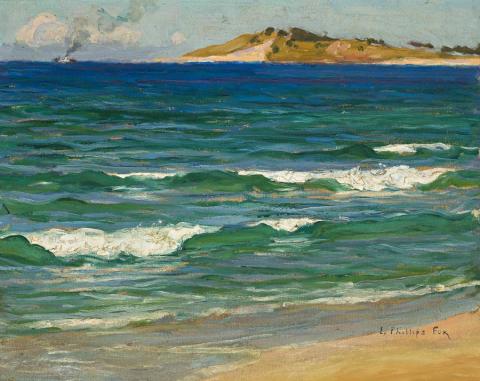SEA AT NARRABEEN, c.1913-14
EMANUEL PHILLIPS FOX
oil on canvas
36.5 x 46.0 cm
signed lower right: E. Phillips Fox
Leonard Joel, Melbourne, 14 July 1955 (label attached verso)
Private collection
Sotheby's, Melbourne, 27 March 1988, lot 85
Private collection, United States of America
Catalogue of Pictures by the Late E. Phillips Fox, Upper Athenaeum Hall, Melbourne, 29 February 1916, cat. 66
Exhibition of Oil Paintings by the Late E. Phillips Fox, Fine Art Society's Galleries, Melbourne, 22 July – 2 August 1919, cat. 40
On extended loan to Newcastle Region Art Gallery, New South Wales (label attached verso)
Zubans, R., E. Phillips Fox: His Life and Art, The Miegunyah Press, Melbourne, 1995, p. 229, cat. 451
Like his friend and contemporary Rupert Bunny, Emanuel Phillips Fox excelled in subject painting, portraits and landscapes, his most memorable works including A Love Story (Art Gallery of Ballarat, Victoria), Bathing Hour, c1909 (Castlemaine Art Gallery and Historical Museum, Victoria), and The Ferry, c1910-11 (Art Gallery of New South Wales, Sydney). Visiting Australia in 1913 with his artist-wife Ethel Carrick, Fox received a number of prestigious portrait commissions the most significant being that of the Prime Minister Andrew Fisher for Canberra's Historic Memorials Collection, and of Henry Giles Turner, President of Trustees of the National Gallery of Victoria. Both Fox and Carrick held exhibitions in Melbourne and Sydney, the Art Gallery of New South Wales purchasing Motherhood, 1908 from Fox's Sydney show at the Royal Art Society. A number of sparkling landscapes and seascapes -Fairy Bower, Manly, Cremorne Point, and Rocks at Balmoral with others - were painted in Sydney prior to the opening, for special inclusion in the exhibition. Such was their popularity that Fox painted more after the exhibition closed, and again in 1914. Fairy Bower, Manly was so favoured that he painted three different versions. 'He had always found scenes of the sea and water seductive', Ruth Zubans noted in her classic study of Fox's work, 'and Manly, with its sun and glorious setting, became on of his favourite sites.'1 The Green Wave, Manly, c1914 (National Gallery of Victoria, Melbourne) is another sunny triumph, so full of colour, atmosphere and vivacity that the viewer is seemingly transported to the scene and the sound of the great wave breaking.
While the waves that break on the shore in Sea at Narrabeen, c1913-14 are different in that they are seen as part of the wider, more panoramic view, the painting has all the same, seductive appeal. Colours are deeper and more sumptuous, the breezy atmosphere enveloping. When exhibited in Fox's posthumous show at the Upper Athenaeum Hall, Melbourne in February 1916, the art critic for The Argus noted that he sometimes handled his landscapes 'by means of dexterous impressionism that fully realised the essentials of the scene he had chosen ...', as much in the joyous, sunny moments of Sydney Harbour as in the south of France. 'The sea', he continued, 'was also a favourite subject with Mr. Fox, and its placid moments appealed to him most. Many striking studies are hung of sunlit waters and stretches of coast in Sydney, Hobart, and Melbourne, Sorrento having supplied motives for three.'2 For Fox, nature was the springboard of his inspiration, the enthusiasm of his response being as readily felt in scenes of Australia's different coastlines as of the Mediterranean.
1. Zubans, R., E. Phillips Fox: His Life and Art, The Miegunyah Press, Melbourne, 1995, p. 165
2.'Late Mr. Fox's Pictures', The Argus, Melbourne, 29 February 1916, p. 9
DAVID THOMAS
